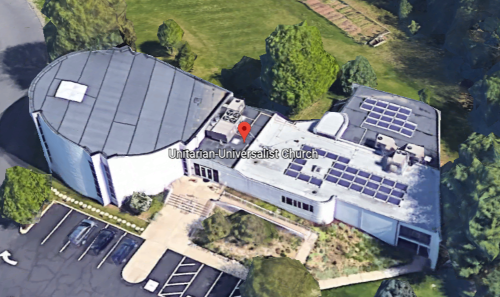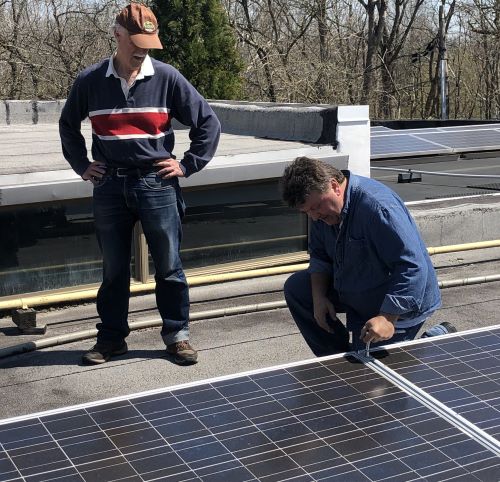by Mark Pokryska and Barbara Drew, for the Earth and Climate Ministry
We have a solar system! No, we do not mean the planets, moon, and stars. Our building’s solar system is much closer – just a few feet above us as we move about the Sanctuary, the Crossings Room, and our classrooms.
Our forty-four Sharp 216-watt solar panels have called our roof home since the fall of 2008. Never noticed them? That’s the idea. The panels were installed to ‘keep a low profile’ yet still be effective. Unless you climb a nearby tree or walk to the very back woods, you can’t see them. The panels unobtrusively produce energy, as they have every day for the last decade and a half.
Following a 2014 building energy audit, Leslie McGeorge, now Earth & Climate Ministry (ECM) Co-chair, asked some “burning” questions. Are our solar panels functioning efficiently or in need of repairs? Will they need to be replaced or expanded soon? How much energy do they produce?
In April 2022, ECM asked church member Mark Pokryska, a solar industry professional, for help evaluating the system. Leslie bravely joined Mark, George Faulkner, and ECM Co-chair Al Johnson for a look at the panels; Barbara Drew observed from the ground.
We are grateful to Mark, who not only gave us his professional assessment of the system but also prepared a technical report with recommendations for our board. (Mark’s technical description of how it works follows.) The report was shared with the Board of Trustees, and the Building, Capital Campaign, and Grounds committees. We appreciate this tremendous service and significant savings to the church for Mark’s report – we would not have been able to get this done otherwise!
Based on Mark’s inspection of the array on the roof as well as the inverters and meters in the utility room, we are pleased to report that the overall system is in good shape!
Our solar panel installation is an affirmation of our commitment to the seventh principle (respecting the interdependent web of all existence of which we are a part). It was also one of the elements of stewardship that earned our designation by UUA as a “Green Sanctuary” in 2010.
In addition to reducing our carbon footprint, our solar system has been reducing our energy costs. Over a period of 15 years, the church has RECEIVED funds from the State of New Jersey. Through what was then the New Jersey Clean Energy Program, we received approximately $2000 per year in Solar Resource Energy Certificates (SREC). An SREC was generated each time a solar system exceeded a milestone of one megawatt hour (yes as in Mega!) of energy production. We estimate that the church received $30,000. This past year, we reached the end of the 15-year eligibility period for SRECs.
How it all works
Solar panels like ours convert a given level of the sun’s radiant energy directly into direct current (DC) electrical energy. What do our solar panels do with this DC electricity? The solar panels can be thought of as the generation part of our Solar System. The DC electrical power they create flows through wires from the roof down into the “mechanical room” in the church basement, which is the home to the next biggest component in our solar system, the inverter. The inverter receives the wires (and power) from the solar panels and through a process known as inversion, converts the direct current electrical energy into alternating current (AC) electrical energy. The inverter, the conversion or power conditioning part of our Solar System, is also connected by wires to the church’s AC power system and to our normal utility grid service or energy provider. The utility grid can be thought of as a part of our solar system as well as a type of energy bank.
We have a Net Metering Agreement with our provider, through which we manage the power produced by our solar system through a monthly billing cycle. It works like this: the power that the solar system generates in excess of what we are currently using is returned to the utility grid. More power generated results in greater benefit to the church. We continue to receive energy from the utility during those periods when the solar system is not producing. Every thirty days, we settle our account with the utility based on the total amount of energy used each twenty-four-hour period minus the total solar contribution over this period.
Since our solar system was activated, it has contributed to offsetting the cost of our monthly purchased utility energy and has reduced our bills for energy while also reducing our carbon footprint. We hope to do further research and analysis to determine our precise savings over the life of the system.
If you have any questions, would like a copy of the Solar Inspection Report Executive Summary, or would like to assist with future solar-related projects, please be in touch with ECM at earthministry@uucwc.org.


